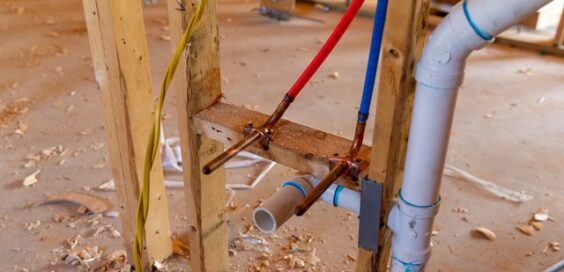Metal Piping 101: What To Use in a New Build
Written by SayBuild-admin // June 25, 2025 // Construction Equipment // Comments Off on Metal Piping 101: What To Use in a New Build

When building a new home, plumbing choices often feel like background noise, until they become a problem. Metal piping, in particular, plays a vital role in keeping water flowing smoothly, safely, and efficiently for years to come.
The material you choose affects durability, cost, ease of installation, and compatibility with your region’s water supply. Whether you’re working with a contractor or taking a more hands-on role, understanding your options will help you make smarter decisions.
Here’s the 101 on what metal piping to use in a new build.
Copper: Tried and True
Copper has long been the gold standard in residential plumbing, and for good reason. It’s corrosion-resistant, lightweight, and has a proven track record of lasting 50 years or more when installed correctly. It’s also a safe material for drinking water, making it ideal for use in kitchens and bathrooms.
If you’re wondering what’s the difference between copper tubing vs. pipe, it comes down to flexibility and use type. Tubing is more malleable and works well in tight or curved spaces.
In contrast, copper pipes are rigid and typically used for longer, straight runs. Both can be soldered or joined with fittings, making copper a reliable and versatile choice for most home builds.
Steel and Galvanized Options
Steel piping, particularly galvanized steel, was a common choice in older homes, prized for its strength and durability. Galvanized steel is treated with zinc to prevent rust, thereby extending its lifespan. However, it’s heavier, more difficult to install, and prone to corrosion over time, especially in areas with hard water.
Today, galvanized steel is primarily used in specific applications, such as outdoor plumbing or where extra durability is required. It’s rarely the go-to for new residential builds, mainly due to the maintenance and potential for mineral buildup inside the pipes.
In most cases, more modern metals or alternatives are better suited for long-term performance.
PEX and Alternatives Aren’t Metal
Although not a metal, PEX (cross-linked polyethylene) warrants mention due to its increasing popularity in residential construction. It’s flexible, affordable, and easy to install, often with fewer fittings. Unfortunately, PEX isn’t suitable for outdoor use due to UV sensitivity, and it’s not always allowed in every municipality.
Homeowners choosing between metal and plastic piping should weigh the pros and cons carefully. While PEX may seem convenient, metal options—particularly copper—still offer unmatched reliability and a longer lifespan in many parts of a home’s plumbing system.
The 101 on what metal piping to use in a new build isn’t just about what works today; it’s about what will still work a decade or two from now. Consider material longevity, water quality, maintenance needs, and future repair costs when making your decision. While some materials may be cheaper upfront, they are more expensive in the long run.
If you’re unsure, consult a licensed plumber who is familiar with local building codes and water conditions. Your piping may be hidden behind walls, but that doesn’t mean it should be an afterthought.
Image Credentials: By Chad Robertson, 286722628








 If you want to contribute tutorials, news or other money-related stuff:
If you want to contribute tutorials, news or other money-related stuff:  Share our home building library with your facebook friends:
Share our home building library with your facebook friends:  Do you have any ideas or suggestions you would like to make?
Do you have any ideas or suggestions you would like to make?  If you like what we do, please subscribe to our
If you like what we do, please subscribe to our  All content Copyright © 2012 SayBuild. Part of nBuy Home Management Network.
All content Copyright © 2012 SayBuild. Part of nBuy Home Management Network.